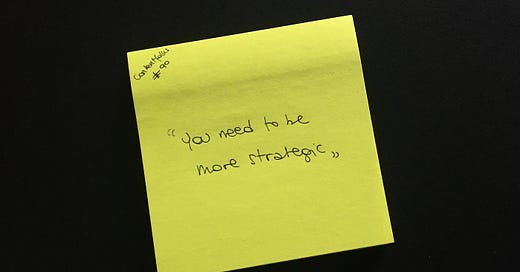You are reading contentfolks—a monthly(ish) blend of sticky notes, big content ideas, and small practical examples. Thank you for being here! ~fio
Hey there 👋
For many in-house folks, it’s performance review season again—aka the time where you may accidentally find yourself on the receiving end of a “you need to be more strategic” note from your manager...
…with ZERO insight into what it is (or isn’t) you should (or shouldn’t) do more (or less) of.
Blah blah be more strategic blah
It is a truth (almost) universally acknowledged that at some point in your career ‘just’ delivering good work stops being enough.
As a junior person, your growth is measured on your ability to:
Be strong at your craft
Take direction
Deliver work that is (nearly) turnkey
Self-manage
Communicate well
The next step in your progression is doing more of the above, better, and faster. Once you’ve mastered that too, the strategy thing will probably happen.
This is where a lot of communication breaks down, because ‘strategic’ is one of those marketing black-hole words that mean different things to different people, and eventually end up meaning nothing to everybody.
The way I see it, being strategic means understanding the business value of your work and behaving accordingly → it’s less about doing good work and more about doing the right work: the kind that aligns with what the business needs to grow and sustain itself.
1. Outcomes > Outputs
When talking about work, spend less time on outputs and more on intended or actual outcomes. Remember: unless you’re in a junior position, your job is not delivering content and hitting due dates. Your job is to influence decision-making in your audience through delivering content while hitting due dates.
❌ Not strategic: “I published X pieces this month.”
✅ Strategic: “As part of our [business goal], I worked on X pieces that will influence [audience] to do [thing]. This work also supports [other team, eg Sales] with [goal]. I’ll keep you posted on the results and share the first update in [these many days]. ”
2. Business goals > your preferences
Accept that great, even excellent work is largely pointless if it’s not aligned with larger business goals and needs.
❌ Not strategic: “I’m excited about [thing] because I’m very good at/interested in it.”
✅ Strategic: “I’m excited about [thing] because it aligns with [company/client goal]. Also, I’m very good at/interested in it.”
3. Bigger picture > narrow view
When pitching ideas, show that you can see the larger picture: bring in relevant evidence, summarise the expected outcome(s), and give a reasonable estimate of time/money/resources needed.1
Bonus points for thinking outside of your function’s bubble and anticipating larger blockers, dependencies, and multipliers that will arise from collaborating with other teams.
❌ Not strategic: “wow omg wouldn’t it be so cool to do [thing]?!?!”
✅ Strategic: “Given [evidence], I recommend we do [thing] because it fits in with [goal] and can impact our ability to achieve [result]. Plus, it would be cool!”
💰 Bonus points: “FYI, to get [thing] done, we will need to loop in [team]. I’ve already checked in with [team manager] and [summary of what I learned].”
4. One impactful task > many non-impactful ones
Somewhat related to the previous point: when you choose to do activity A, you’re at the same time choosing not to do activities B and C. The choice may be obvious to you, but people cannot generally read your mind: show your thought process and the logic you followed.
❌ Not strategic: “Let’s do [thing], and also [other thing], and then [new thing].”
✅ Strategic: “Given [evidence], we should stop doing [other thing] for now and just focus on [thing] instead; it’s the most likely to lead to [key result] in [timeframe].”
5. Team > individual
By this point, it should be clear that being ‘more strategic’ has a lot to do with seeing beyond what you’re responsible for—and sometimes, that simply means taking tasks off other people’s plates.
Observe what the folks sitting above you in the org chart are doing, or ask them directly about what’s top of mind; then, proactively align your work in their direction without being asked to.
❌ Not strategic: [silence]
✅ Strategic: “Hey boss, let me drive [task] from [initiative] forward so you can stay focused on [larger task].”
🔥 Bonus pro tip
If you pay close attention to the previous five examples, you may notice a pattern: clear, effective, and proactive communication goes a long way to make you come across as a strategic player.
Indeed, it’s entirely possible that ‘more strategic’ is not a state of being you reach but a perception you unlock—specifically, that of your clients or the folks one or two steps ahead of you in the company org chart. They spend most of their time trying to solve large problems, want to know they can rely on you, and are probably writing your performance review right about now.
Act accordingly.2
A good companion read: How (not) to present an idea, by Benyamin Elias.
Some additional (and solid) advice in this archived piece by Lesley Sim, who calls it ‘thinking one level up the food chain,’ and this piece by Dimitri Glazkov who thinks of strategy as a team sport.






Thank you for sharing your thoughts! When growing from a junior copywriter to a content marketer, I was regularly told, 'Think bigger,' 'See the bigger picture,' and 'Think about business value.' It was hard because it meant shifting my mindset from, 'I wrote 10 articles this week,' to, 'I wrote this because it will help us achieve this business goal'. But eventually, I nailed it, and it was absolutely worth it :)
Wish I read this earlier in my career! Love this format too.